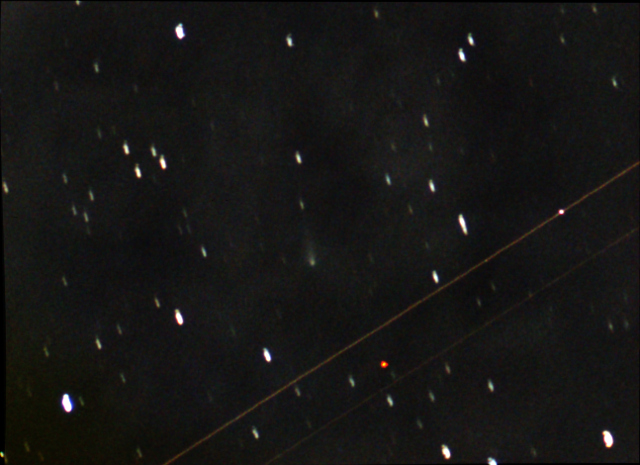This case of a "UFO" submitted to Mufon, is described as:
https://mufoncms.com/cgi-bin/report...=f1_submitted_datetime+DESC&case_number=91964
The first impression was correct. However, the resultant photo seems a little confusing.2018-05-08
8:59PM
Amber colored light pattern observed thru a telescope. Aztec, NM, US
I was in my backyard doing astrophotography. My subjects that night were a pair of galaxies in the spring sky, NGC4631 and NGC4656 in the constellation Canes Venatici. My equipment was a 103mm apochromatic refractor and a Canon EOS 6d DSLR. I was shooting 3 minute sub frames at the time. The object appeared on one of my subframes as it crossed thru the field of view. My first impression was that it was some satellite or high flying aircraft. One of my submitted photos shows how far the object moved across the frame during this particular 3 minute exposure. I just continued shooting more 3 minute frames of the galaxy field with the intention of deleting this frame from my total set of 15 frames to be stacked later for the final picture. The object never appeared in any of my other frames and I did not see anything like it again that night. NOTE: The dimensions of the galaxy the object flew by ( NGC4631 ) is approx. 10' x 1.5' of arc. so the object would have been quite small. Its astronomical magnitude was estimated at 8.0
The problem is that you naturally interpret this as a set of three lights. But what it actually is is a single light, the red collision avoidance strobe. This is a very bright flashing light, that illuminates other parts of the plane, even in the daytime.
In this case, it's illuminating the engines.
Another clue are the two faint bright red spots under the main light
This matches quite well with the wheel wells of a 737
The time given is 2018-05-08 8:59PM, that's 2018-05-09 (next day) 2:59AM in UTC. The camera EXIF time gives the same UTC time - maybe that's common for astrophotography? Looking at that location, a likely candidate is SWA1988 from Phoenix to Omaha, which was passing just to the South at 39,000 feet.
Another thing that throws people off here is the thin lines. These are the long exposure traces of navigation lights, but they seem odd as you can only see two of them, and they don't seem to line up with the other lights. However, if you look carefully, or just boost the levels, then you can see there actually are three lines.
What's more, the one on the left is green, and the one on the right is red, which matches standard wingtip lights.
They don't line up for a somewhat unintuitive reason - planes do not fly in the direction they are facing. They fly in the direction they are facing at their airspeed PLUS the velocity of the wind relative to the ground. So if there's a crosswind, the motion of the plane can be 5° or more off from the direction it is facing.
Attachments
Last edited:

